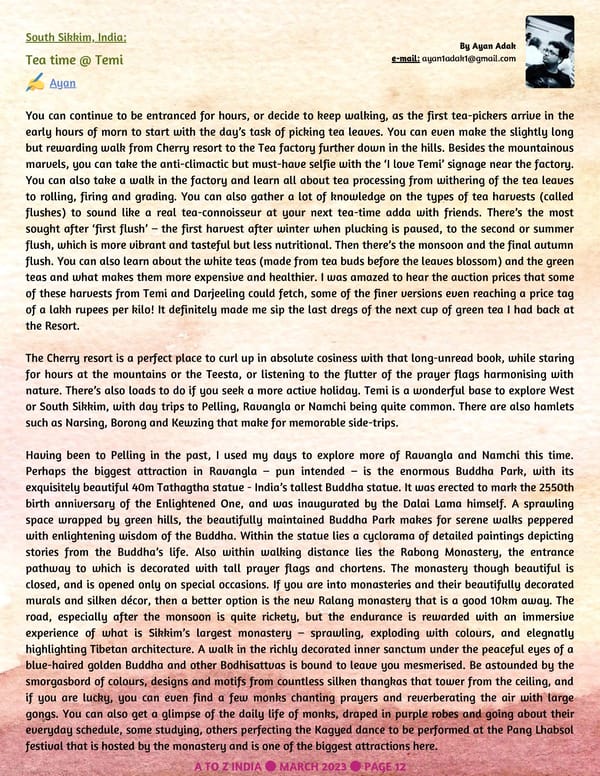South Sikkim, India: By Ayan Adak e-mail: [email protected] Tea time @ Temi Ayan You can continue to be entranced for hours, or decide to keep walking, as the first tea-pickers arrive in the early hours of morn to start with the day’s task of picking tea leaves. You can even make the slightly long but rewarding walk from Cherry resort to the Tea factory further down in the hills. Besides the mountainous marvels, you can take the anti-climactic but must-have selfie with the ‘I love Temi’ signage near the factory. You can also take a walk in the factory and learn all about tea processing from withering of the tea leaves to rolling, firing and grading. You can also gather a lot of knowledge on the types of tea harvests (called flushes) to sound like a real tea-connoisseur at your next tea-time adda with friends. There’s the most sought after ‘first flush’ – the first harvest after winter when plucking is paused, to the second or summer flush, which is more vibrant and tasteful but less nutritional. Then there’s the monsoon and the final autumn flush. You can also learn about the white teas (made from tea buds before the leaves blossom) and the green teas and what makes them more expensive and healthier. I was amazed to hear the auction prices that some of these harvests from Temi and Darjeeling could fetch, some of the finer versions even reaching a price tag of a lakh rupees per kilo! It definitely made me sip the last dregs of the next cup of green tea I had back at the Resort. The Cherry resort is a perfect place to curl up in absolute cosiness with that long-unread book, while staring for hours at the mountains or the Teesta, or listening to the flutter of the prayer flags harmonising with nature. There’s also loads to do if you seek a more active holiday. Temi is a wonderful base to explore West or South Sikkim, with day trips to Pelling, Ravangla or Namchi being quite common. There are also hamlets such as Narsing, Borong and Kewzing that make for memorable side-trips. Having been to Pelling in the past, I used my days to explore more of Ravangla and Namchi this time. Perhaps the biggest attraction in Ravangla – pun intended – is the enormous Buddha Park, with its exquisitely beautiful 40m Tathagtha statue - India’s tallest Buddha statue. It was erected to mark the 2550th birth anniversary of the Enlightened One, and was inaugurated by the Dalai Lama himself. A sprawling space wrapped by green hills, the beautifully maintained Buddha Park makes for serene walks peppered with enlightening wisdom of the Buddha. Within the statue lies a cyclorama of detailed paintings depicting stories from the Buddha’s life. Also within walking distance lies the Rabong Monastery, the entrance pathway to which is decorated with tall prayer flags and chortens. The monastery though beautiful is closed, and is opened only on special occasions. If you are into monasteries and their beautifully decorated murals and silken décor, then a better option is the new Ralang monastery that is a good 10km away. The road, especially after the monsoon is quite rickety, but the endurance is rewarded with an immersive experience of what is Sikkim’s largest monastery – sprawling, exploding with colours, and elegnatly highlighting Tibetan architecture. A walk in the richly decorated inner sanctum under the peaceful eyes of a blue-haired golden Buddha and other Bodhisattvas is bound to leave you mesmerised. Be astounded by the smorgasbord of colours, designs and motifs from countless silken thangkas that tower from the ceiling, and if you are lucky, you can even find a few monks chanting prayers and reverberating the air with large gongs. You can also get a glimpse of the daily life of monks, draped in purple robes and going about their everyday schedule, some studying, others perfecting the Kagyed dance to be performed at the Pang Lhabsol festival that is hosted by the monastery and is one of the biggest attractions here. A TO Z INDIA ● MARCH 2023 ● PAGE 12
 A TO Z INDIA - MARCH 2023 Page 11 Page 13
A TO Z INDIA - MARCH 2023 Page 11 Page 13